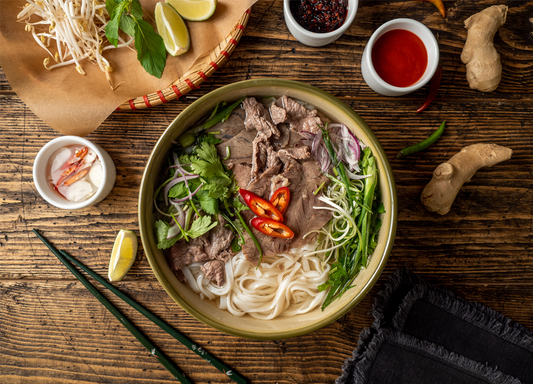The History and Evolution of Pho: From Street Food to Restaurant Staple

Introduction: A Culinary Journey
Pho, the fragrant Vietnamese noodle soup, is more than just a meal—it's a symbol of cultural heritage and culinary evolution. This beloved dish, characterized by its aromatic broth, tender meat, and fresh herbs, has transitioned from humble street food to a prominent restaurant staple both in Vietnam and across the globe. The history and evolution of pho reflect broader trends in Vietnamese society and global food culture, illustrating how a simple dish can captivate and transform over time. This article explores the origins of pho, its development through the years, and its journey to becoming a cherished global cuisine.
Origins of Pho: A Culinary Fusion
1. Early Beginnings:
The exact origins of pho are somewhat elusive, with various theories regarding its inception. The most widely accepted view is that pho emerged in northern Vietnam in the early 20th century during the French colonial period. The dish is believed to have been inspired by the French pot-au-feu, a beef stew that was adapted by Vietnamese cooks using local ingredients and flavors. The French influence, combined with traditional Vietnamese culinary practices, led to the creation of pho, which featured a clear beef broth, rice noodles, and a blend of spices and herbs.
2. The Birth of a Classic:
Pho's early popularity was rooted in its accessibility and affordability. Street vendors in Hanoi began selling pho from carts and small shops, where the soup was prepared and served in simple, no-frills settings. This made pho a popular choice for working-class individuals and families. The simplicity of the dish, combined with its comforting flavors, contributed to its widespread appeal.
Post-War Era: Expansion and Innovation
1. Post-Vietnam War Development:
The Vietnam War (1955-1975) had a profound impact on Vietnamese society and its cuisine. After the war, many Vietnamese people emigrated to different parts of the world, bringing their culinary traditions with them. Pho, in particular, gained recognition outside Vietnam as Vietnamese immigrants introduced the dish to new communities. As Vietnamese diaspora communities settled in countries such as the United States, Canada, Australia, and France, pho restaurants began to emerge, serving as both a culinary connection to home and a way to introduce Vietnamese culture to a broader audience.
2. Regional Variations:
As pho spread beyond Vietnam, regional variations began to develop. In the southern city of Ho Chi Minh City (formerly Saigon), a sweeter and more aromatic version of pho emerged, incorporating additional herbs and spices. Conversely, northern Vietnam's version of pho is typically more straightforward, focusing on the purity of the beef broth and subtle seasoning. These regional differences highlighted the adaptability of pho and its ability to evolve while maintaining its core essence.
Pho in the Global Culinary Landscape
1. The Rise of Pho Restaurants:
As pho gained international recognition, it transitioned from being a street food staple to a prominent feature in Vietnamese restaurants worldwide. Pho restaurants began to appear in major cities, offering an array of pho variations to cater to diverse tastes and preferences. These establishments often presented pho in a more refined setting, with a focus on quality ingredients and presentation. The rise of pho restaurants also coincided with an increased interest in global cuisines, leading to greater appreciation for pho's unique flavors.
2. Fusion and Innovation:
The global popularity of pho has inspired numerous culinary innovations. Chefs around the world have experimented with fusion dishes that blend traditional pho elements with other cuisines. For example, pho burgers, pho tacos, and pho-inspired pasta dishes have emerged, showcasing the versatility of pho and its ability to adapt to different culinary contexts. This innovation has helped introduce pho to new audiences and keep the dish relevant in a rapidly changing food landscape.
Modern Adaptations: Health Trends and Dietary Needs
1. Plant-Based and Vegan Options:
In response to growing interest in plant-based diets, many pho restaurants have introduced vegan and vegetarian versions of the dish. These adaptations often feature plant-based broths made from mushrooms, vegetables, and spices, as well as meat substitutes like tofu or seitan. By catering to diverse dietary preferences, pho restaurants are ensuring that the dish remains accessible to a broader audience while maintaining its traditional flavors.
2. Gluten-Free and Low-Carb Alternatives:
As awareness of gluten sensitivity and low-carb diets increases, pho restaurants have begun offering alternative options. Gluten-free noodles and low-carb substitutes, such as zucchini noodles or shirataki noodles, are now available at many establishments. These adaptations allow diners with specific dietary needs to enjoy pho without compromising on taste or texture.
Pho in Popular Culture: Media and Recognition
1. Media Appearances:
Pho has garnered attention in various media outlets, including food documentaries, cooking shows, and travel programs. These media features have played a significant role in popularizing pho and showcasing its cultural significance. The dish's appearances in mainstream media have helped to elevate its status as a global culinary icon and introduce it to new audiences.
2. Culinary Awards and Recognition:
The rise of pho restaurants has also led to recognition and accolades within the culinary world. Award-winning pho restaurants and chefs are celebrated for their dedication to authenticity and innovation, contributing to the dish's esteemed reputation. This recognition further solidifies pho's place in the global food scene and highlights its continued relevance.

Conclusion: A Dish with a Rich Legacy
The history and evolution of pho reflect its journey from a humble street food to a beloved global cuisine. Originating in northern Vietnam, pho has undergone significant changes and adaptations as it spread to different regions and cultures. Its transition from street food to a restaurant staple, along with its adaptation to modern dietary trends, demonstrates the dish's enduring appeal and versatility.
As pho continues to evolve and capture the imaginations of food enthusiasts worldwide, it serves as a testament to the power of food to connect people, cultures, and traditions. Whether enjoyed in its traditional form or through innovative adaptations, pho remains a cherished and influential dish, celebrated for its rich history and its ability to bring people together over a shared love of flavorful and comforting food.




